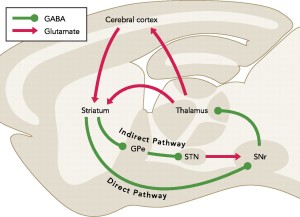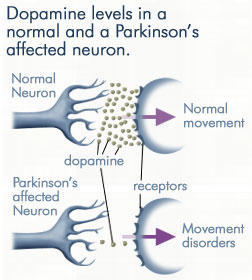I have had the pleasure of being able to participate in UCL’s summer challenge where students wrote an essay about a topic that they have spent six weeks learning about and doing independent research on. It gave a real insight into undergraduate study, both the challenges you face and the skills you have the opportunity to develop. I wrote an essay comparing two neurological diseases. However, rather than all of the amazing and challenging content I have learnt, the main thing that I will take away from completing the UCL summer challenge is how to be an independent learner. Writing the essay has taught me how to research effectively, how organisation is a key skill in being able to be a proactive learner along with time management skills, how to present confidently and how to be a mature writer. I hope you enjoy my essay.
http://www.ucl.ac.uk/prospective-students/widening-participation/activities/summer-challenge
Parkinson’s disease vs. Huntington’s disease
Parkinson’s disease is a progressive neurodegenerative disorder characterised by the deterioration of motor functions as a result of declining dopamine-producing brain cells. Huntington’s disease is a hereditary neurodegenerative disorder; it is also concerned with worsening motor function due to the degeneration of the basal ganglia and cerebral cortex. These diseases are currently incurable, however, with current management and proper treatment, patients are able to live a relatively high quality of life by slowing down the progression of the diseases. This essay will compare the two neurological diseases by looking at several factors, for example, the prevalence of each disease, genetics and risk factors.
Parkinson’s disease is a late onset neurological disease caused by the loss of dopamine as a result of damage to dopaminergic neurons in the substantia nigra. The substantia nigra is a brain structure found in the midbrain above the spinal cord and is thought to be responsible for controlling movement. Dopamine is a neurotransmitter which is responsible for sending signals from the substantia nigra to other brain regions; there are studies in which Parkinson’s patients have lost 60% to 80% of dopamine-producing cells. When the dopamine levels between the substantia nigra and corpus striatum is significantly low, it can lead to symptoms that are associated with Parkinson’s disease. The primary symptoms of Parkinson’s disease are mainly related to movement. These include tremors, rigidity, postural instability and bradykinesia (slowness of voluntary movement). Patients can also develop a Parkinsonian gait, which is when patients develop a shuffling way of walking with an arched position and the absence of an arm swing. This symptom complex is known as Parkinsonism. Primary Parkinsonism is Parkinsonism that is caused by Parkinson’s disease. Parkinsonism caused by other diseases is known as secondary Parkinsonism.
Parkinson’s disease is a progressive disorder that increasingly affects movement and muscle control. The basal ganglia is a collection of nuclei that regulates movement and without information from the basal ganglia, the cortex is unable to direct motor control. This leads to the regression of motor function and hence, Parkinson’s disease. There are two pathways by which dopamine is released to either stimulate or inhibit movement. The direct pathway stimulates movement. The motor cortex excites the putamen by releasing glutamate, which is an excitatory neurotransmitter. This increases the activity of the putamen, which is an inhibitory nuclei, which means that the putamen will increase the inhibitory effect on what it acts on. As a result, the putamen releases increased levels of GABA, an inhibitory neurotransmitter, to the globus pallidus internus, which is what the putamen acts on. This reduces the activity of the globus pallidus internus. The globus pallidus internus is an inhibitory nuclei therefore reduced activity leads to a decrease on the inhibition of the thalamus as less GABA is transmitted. Therefore, the activity in the thalamus increases, which excites the primary motor cortex. The primary motor cortex can then excite muscles leading to movement. The substantia nigra stimulates the direct pathway. It releases dopamine into the striatum which binds to the D1 receptors; this causes movement to increase. The indirect pathway inhibits movement. The motor cortex, again, excites the putamen by sending increased amounts of glutamate. Due to the fact that the putamen is an inhibitory nuclei and its activity has increased, there is an increase in the inhibition of the globus pallidus externus. Consequently, the activity of the globus pallidus externus decreases which decreases the inhibition on the globus pallidus internus causing the activity of the thalamus to also decrease. Decreased activity of the thalamus, which is an excitatory nuclei, means that the primary motor cortex is not excited as much therefore the motor cortex cannot excite the muscles, inhibiting movement. The substantia nigra inhibits the indirect pathway, as the dopamine that is released binds to D2 receptors. This results in increased movement. In Parkinson’s disease, the progressive loss of dopamine producing neurons in the substantia nigra causes deterioration of the ability to move voluntarily.

Huntington’s disease is an inherited disorder that causes the progressive breakdown of nerve cells in the brain, specifically the basal ganglia and the cerebral cortex. They are thought to be responsible for movement and the way we think, comprehend and retain information. Huntington’s disease causes movement, cognitive, behavioural and psychiatric disorders, therefore, the most common symptoms are mood swings, tremors, memory loss and an impaired gait. Unlike Parkinson’s disease, Huntington’s disease is known to be caused by faulty genes.

Huntington’s disease is caused by a mutation on the fourth of the twenty three chromosomes whereas in Parkinson’s the cause is idiopathic in most cases. In Huntington’s there is a mutation in the HTT gene, which codes for the protein huntingtin. The exact function of the protein is unknown, however, it appears to play an important role in nerve cells in the brain. The mutation causes the CAG trinucleotide to repeat. CAG repeats of 26 or fewer are normal however, if the CAG repeats exceeds 40, Huntington’s disease is expressed. Repeats of the CAG nucleotide between 27 and 35 do not express the disease but can expand with paternal transmission, and as a result, their offspring having the disease. If one parent is a carrier of Huntington’s disease, there is a 50% chance of inheriting the gene. Huntington’s disease is a dominant disease which means you only need one allele for the disease to be expressed. If both parents have Huntington’s disease, which is incredibly infrequent, the chance of an offspring developing Huntington’s is 75%. In Parkinson’s disease, people with a family history of Parkinson’s are more likely to develop the disease, which prompts the idea that genes play a role in causing it. So far, five genes have been identified that are definitively associated with Parkinson’s – SNCA, PARK2, PARK7, PINK1 and LRRK2. SNCA makes the protein alpha synuclein and in the brain of Parkinson’s patients, it is known to aggregate in clamps called Lewy bodies that develop in the nerve cells.
In Huntington’s disease, the CAG (cytosine-adenine-guanine) repeats in the huntingtin gene can lead to the loss of neurons in the striatum and cortex. The roles of the protein huntingtin include protein trafficking, transporting vesicles and postsynaptic signalling among others. Due to the loss of neurons, the normal protein loses its function and gains a toxic function of huntingtin, which contributes to the disruption of several intracellular pathways. The progressive degeneration traditionally observed in Huntington’s is a result of these disruptions, for example, dopamine toxicity, metabolic impairment and apoptosis (cell death), which lead to recognisable symptoms.

The risk factors that are associated with Parkinson’s disease are being male, older age, having a history of concussions, gene mutations, exposure to pesticides/chemicals, and breathing in heavy metal particles, for example, lead, iron and copper. For Huntington’s disease, there are no known risk factors, however it is more common among Europeans, who live in Europe, North America and Australia. In addition, Huntington’s very rarely occurs in other ethnicities and countries. The average age of diagnosis for Parkinson’s disease is 60 to 65, but in 5% to 10% of cases, diagnosis is made before the age of 50. The mean age of being diagnosed is lower in Huntington’s with most people discovering they have Huntington’s disease at the age of 40.
According to research carried out by Parkinson’s UK, there are currently 127,000 people in the UK with Parkinson’s, which is 7,000 more than the figure was previously thought to be. They also predict that this figure is set to rise by 28% by 2020 due to the fact that the UK has an ageing population. The Huntington’s Disease Association (HDA), have data of 541 children with juvenile Huntington’s disease and 6,161 adults with symptomatic Huntington’s disease. These figures, however, are a conservative estimate as the figures only include patients who have been in contact with the HDA.
Despite the fact that there are currently no treatments that cure either disease, patients are able to manage their symptoms by taking medication or undergoing surgery, for example, having deep brain stimulation to electrically stimulate the motor circuit to help with movement related symptoms. There is also currently lots of research going into developing new drugs which may have the potential to cure the diseases. Recently, research in the journal Plos Medicine showed that drugs for diabetes, glitazone pills, may prevent Parkinson’s disease.
